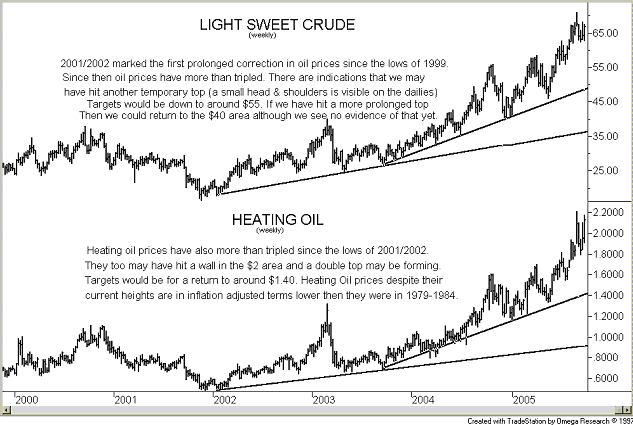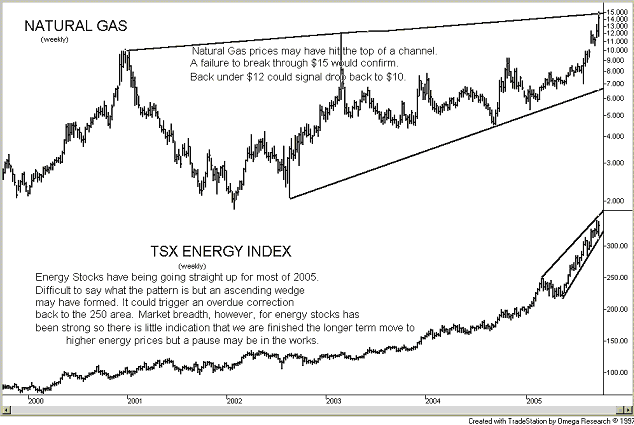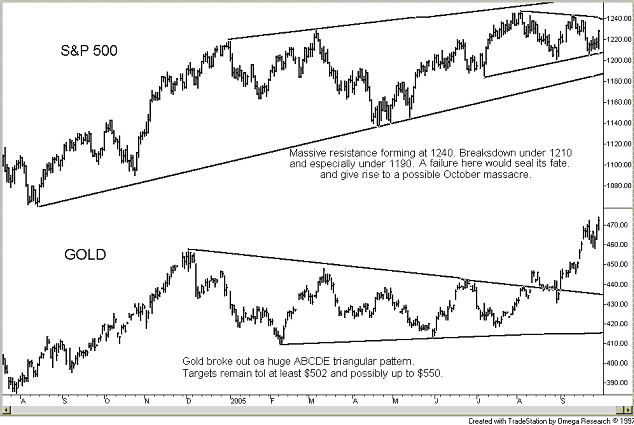|
FRIDAY EDITION January 2nd, 2026 |
|
Home :: Archives :: Contact |
 |

TECHNICAL SCOOPDavid Chapman of Union Securities Ltd. www.davidchapman.com October 1st, 2005
War and ReconstructionThe devastation caused by Hurricanes Katrina and Rita will undoubtedly be the most expensive disaster in US history. Estimates of the cost are all over the map. Numbers of $100 to $200 billion are being tossed around in congress. And that is just for Katrina. We are already seeing numbers of $44 billion for Rita where the damage has been seriously underestimated. Since Hurricane Katrina struck on August 29 US congress has already approved some $71 billion of spending bills and tax cuts. A further $9 billion was approved for Medicaid and an additional $5 billion was approved for housing, education and small-business assistance. This may be only the beginning. As we noted, overall costs are being estimated to be $100 to $200 billion and it could be up to $250 billion. A Louisiana congressional delegation is seeking $250 billion. $32 billion was requested by Louisiana for Hurricane Rita. Texas requested at least $8 billion. Insurance losses are estimated to be upwards of $66 billion for Katrina and up to $8 billion for Rita. The trouble with all of these costs is that no one knows as the devastation has been wide spread and these are just estimates. With over a month to go in the hurricane season one can only shudder at the thought of the cost of another monster hitting the Gulf or anywhere for that matter. The knocking out of roughly 25% of the USís oil and gas and refinery production for what could be an indeterminate period is fuelling the spectre of fuel shortages in coming months. Once again this is an area where the damage to the oil and gas rigs in the Gulf and the refineries along the coast has been underestimated. Consumers are seeing higher prices at the gas pumps and they are threatened with sharply higher heating costs this winter that can only bite into consumer spending. Higher gas and heating prices are like an additional tax on the economy. It is no surprise then that consumer confidence plunged to its lowest levels since October 2003 (81.7). At 86.6 it was well below the expected 95. In order to offset the growing gasoline shortage President Bush has asked American consumers to conserve energy by driving less. This coming from the oil president can only be viewed as bizarre. Consider that the US consumes 25% of global energy resources and individuals think nothing of having a gas guzzling SUV for every family member and drive to the corner store to pick up a loaf of bread and a jug of milk. Most major cities are lacking in significant mass transit infrastructure. Americans (and Canadians) are so used to and dependent on using the automobile that it is difficult to break the habit. With rising credit card debt and delinquencies also rising, the additional impact of higher fuel prices will act as a further drag. It is estimated that upwards of a million people have been left homeless by the dual hurricanes making it the largest migration of Americans since the dustbowl of the Great Depression. Tens of thousands will be swelling the unemployment rolls in the coming months. Costs for Medicaid are soaring and already differences are rising in Congress over the payment and eligibility of Medicaid as numerous people that were not eligible before are suddenly eligible or at least they would hope they are having now become suddenly destitute. The reconstruction of the Gulf States along the coasts of Alabama, Louisiana and Texas will no doubt be in the billions as the estimates being tossed around indicate. As well no doubt the political battles of how to pay for it will be nasty as there have been promises to halve the deficit by 2009. But no matter how heated the discussions get on how to pay for it and what to cut what we do know is that expenditures for the War in Iraq and the War on Terror (Homeland Security) will not change. The US budget deficit was $412 billion in 2004 and was expected to be lower in 2005. Not any more. War and reconstruction will not allow for it. War and reconstruction is a theme that has appeared in American history on more than one occasion. The two that clearly come to mind are the American Civil War 1861-1865 and the reconstruction that followed after the war when the economy of the Confederate States was destroyed and the War in Vietnam that began with the US training troops in 1956 and didnít end until the evacuation of Saigon in 1975 playing out with Lyndon Johnsonís war on poverty (1964-1968). Today it is the War in Iraq, the War on Terror and reconstruction in the Gulf States. So are there any similarities with previous periods of war and reconstruction? The answer is not readily apparent. War and reconstruction in the period of the Civil War was a war followed by reconstruction. In terms of the Kondratieff seasons, the Civil War occurred during an commodity inflation/recession period and was a classic Kondratieff summer. The period of reconstruction that followed set off an economic boom coinciding as it did with the westward expansion of the American Empire a classic autumn period of the Kondratieff cycle. It wasnít until the boom busted in the mid-1870ís that the US fell into a depression even as westward expansion continued during the age of the railroad and against the backdrop of the Indian Wars. The period of the Vietnam War had its start during a period of economic expansion in the spring of a Kondratieff cycle following the long period of depression and war in the 1930ís and 1940ís. The War in Vietnam coupled with the war on poverty in the 1960ís set off a huge commodity/wage inflationary period and as well started the US on its way to running huge budget deficits to pay for the wars. The period was dominated economically by the severe recessions of 1974-1975 and 1981-1982 and was a classic Kondratieff summer. This time it is different. The US was already running record budget deficits near 4% of GDP and Fed Chairman Alan Greenspan has expressed concern that the US has ďlost controlĒ of their budget deficits. There is a serious balance of payments deficit now some 6% of GDP although some argue that it is not that significant so long as the recycling of the US$ continues with the US buying goods and the rest of the world financing the deficit. Employment growth has been below previous expansions. The consumer is running record debt levels and credit card and mortgage delinquencies are rising sharply. Greenspan has expressed concern about a potential housing bubble fuelled by low interest rates and easy monetary conditions (odd to state considering it was his policies that laid the foundation for the bubble). The devastation in the Gulf States has triggered a raft of mortgage defaults as thousands of people are now unemployed and their homes have been destroyed or flooded. The rhetoric and concern from numerous corners that despite war and reconstruction that targets of halving the budget as planned must continue is merely partisan politics as the odds of it actual happening are slim to none. The huge amounts required for reconstruction are, well, just too large. Two of the districts hard hit by the hurricanes are represented by freshmen both of who owe their seats to redistricting through the now criminally indicted Tom DeLay. In order to keep seats funds will flow to ensure they stay in Republican hands. Indeed all the states hit by the hurricanes were Republican states and despite cries from some fiscal conservatives the funds will flow. Already there are stories of uncontested contracts being handed to select corporations (Halliburton). All of this is complicated by the commitments for defense spending already pegged at $440 billion for 2006 including another $50 billion for Iraq. And the so-called pork? Well too much of it is destined for states that are key Republican states that are up for re-election in 2006. One of the major problems now is the now high cost of energy. While the world is probably experiencing a temporary glut of oil due to the release from strategic reserves, an increase in production and we are entering the slack demand season between the driving season and the heating season. So there is the probability that oil prices have topped for the moment. But that has not impacted the price of gasoline at the pumps nor may it save higher prices for heating oil in the winter. With a number of refineries down for probably at least a few months high gasoline prices will remain. There are areas of excess refinery capacity but it is not in the US where no new refineries have been built since the mid-1970ís. Indeed it has been revealed that Saudi Arabia and Kuwait offered refined products from their refineries that have been built up over years but that it was turned down by the White House (Executive Intelligence Review Ė September 23, 2005). During the past year oil prices have jumped some 60% while Natural Gas prices have doubled. Some believe that there is upwards of $30/$40 premium in oil prices which is a terror premium and that it is purely speculative. Indeed since May oil prices are up over 30%. The period of the rise in oil prices has coincided with period of focus on hedge funds. It was in the early summer that the bond rating agencies cut the ratings on General Motorís corporate bonds to junk. Numerous hedge funds were long the bond and short the stock. But at the same time Kirk Kerkorian announced he was buying GM stock and GMís stock soared. So the hedge funds were caught out both ways. Other hedge funds have been investigated for fraud two in particular KL Financial and Bayou Management LLC where potential losses are in the hundreds of millions. Here in Canada investigations continue into Portus Alternative Asset Management that is facing law suits and has been placed in receivership. There is estimated to be currently over $1 trillion in hedge funds. Hedge funds have become so huge and complex that any problem that develops could quickly mushroom into a huge problem and spark huge losses. Complicating it further is that numerous bank and investment dealer dealing desks are also trading in the same instruments. And the banking industry is laden with an $8.4 trillion credit derivatives market that could under the wrong circumstances also blow up in their faces. So there are some who believe that recent sharp rise in oil prices in particular is not all due to supply and demand but rather a way to bail out problems looming in the hedge fund/banking/investment dealer industry. Keeping the possibility of higher oil prices alive is the ongoing rhetoric surrounding alleged nuclear ambitions of Iran. This is now being referred to the UN Security Council where any sanctions against Iran are sure to be vetoed by Russia and China both of who have billions of investments in the country particularly in the oil industry. Iran is a major oil producer. Still this may not stop an attack on Iran. The Pentagon has long outlined plans for limited nuclear attacks on non-nuclear adversaries through its Nuclear Posture Review in December 2001 and the Doctrine for Joint Nuclear Operations in March 2005 (both at www.globalsecurity.org). Iran as well is on the verge of starting the Iranian Oil Bourse that will trade oil in Euros. This would be a major problem for the US$ (see Petrodollar Warfare: Dollars, Euros and the Upcoming Iranian Oil Bourse by William R. Clark at http://usa.mediamonitors.net/content/view/full/17450). We note that prior to the invasion of March 2003 Iraq accepted payment for oil in Euros only. After the successful invasion Iraq reverted to accepting payment in US$ once again. Oil, war and now reconstruction. All this against a backdrop of rising budget deficits and a squeezed consumer. With the markets still trying to put in new highs we wonder how long it can continue before they realize there is a problem. A break of 1190/1200 on the S&P 500 would signal that a sharp October drop was in the works. Failure to sustain a close over 1226 would signal that the upside is spent. While the market has been rising other internal indicators such as market breadth have not being confirming. There is also considerable speculative fever concerning future oil prices so we may be due for a pause especially since we note we are going into the in between period of the summer driving season and the winter heating oil season. A pause now would take some of the speculative fever out of the group. Throughout all of this gold has been rising steadily despite some sharp ups and downs. This is occurring despite no sharp drop in the US$ that has held in remarkably well. Could gold be anticipating a bigger problem? Behind the scenes the problems are certainly gathering. Reconstruction, hedge funds, political problems in Washington (low polls for President Bush, the ongoing War in Iraq that just goes on and on, the problems of Tom DeLay, a possible revival of the Valerie Plame affair with the release of Judith Miller). Gold is the currency of last resort and where people will flee to in times of troubles. Breaking out to new highs here keeps alive the targets of up around $500 (where there is some very long term resistance dating from the highs of 1987). Investors should be very wary that reconstruction has been added to the war equation. The past record does not bode well for the future. 

 David Chapman is a director of Bullion Management Services the manager of the Millennium Bullion Fund Note: Chart created using Omega TradeStation or SuperCharts. Chart data supplied by Dial Data. The opinions, estimates and projections stated are those of David Chapman as of the date hereof and are subject to change without notice. David Chapman, as a registered representative of Union Securities Ltd. makes every effort to ensure that the contents have been compiled or derived from sources believed reliable and contain information and opinions, which are accurate and complete. Neither David Chapman nor Union Securities Ltd. take responsibility for errors or omissions which may be contained therein, nor accept responsibility for losses arising from any use or reliance on this report or its contents. Neither the information nor any opinion expressed constitutes a solicitation for the sale or purchase of securities. Union Securities Ltd. may act as a financial advisor and/or underwriter for certain of the corporations mentioned and may receive remuneration from them. David Chapman and Union Securities Ltd. and its respective officers or directors may acquire from time to time the securities mentioned herein as principal or agent. Union Securities Ltd. is an independent investment dealer and is a member of the Toronto Stock Exchange, the Canadian Venture Exchange, the Investment Dealers Association and the Canadian Investor Protection Fund. |
| Home :: Archives :: Contact |
FRIDAY EDITION January 2nd, 2026 © 2026 321energy.com |
|